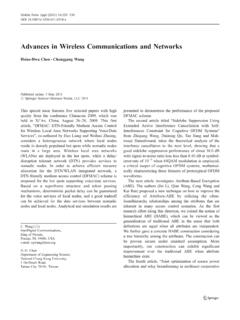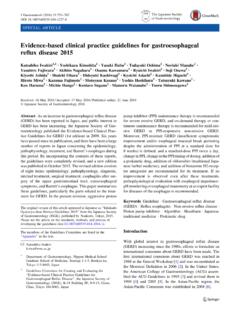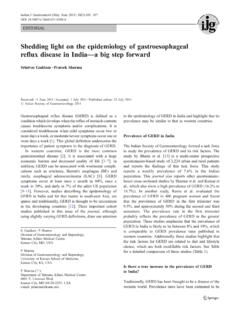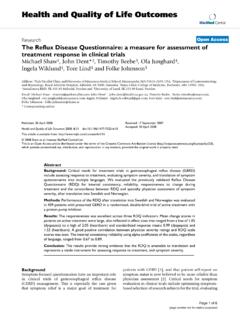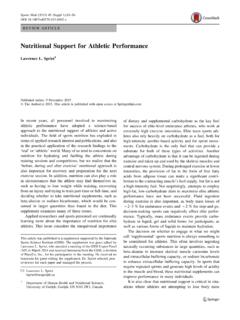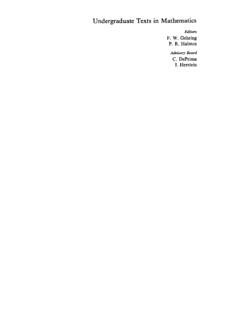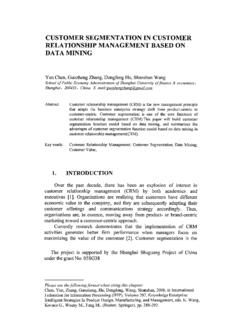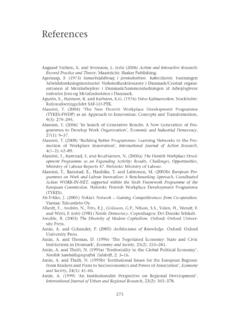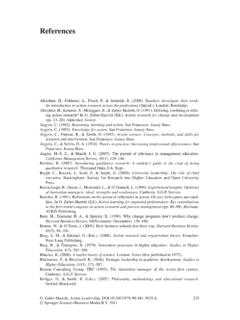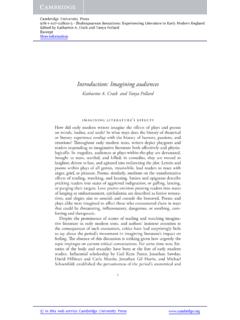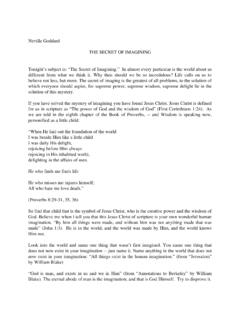Transcription of 1 The secret complement - Home - Springer
1 1 the secret complement Tristram Shandy was convinced that no author who understood the 'just boundaries' of decorum and good breeding would 'presume to think all': The truest respect which you can pay to the reader's understanding is to halve this matter amicably, and leave him something to imagine, in his turn, as well as yourself. For my own part, I am eternally paying him compliments of this kind, and do all that lies in my power to keep his imagination as busy as my own. It could fairly be said that modern poets have been paying the reader compliments of this kind for some time now, and that they have long been content to halve the matter as amicably as Tristram once did. 'Every work,' Paul Valery explained, 'is the work of many things besides an author.' Valery's testimony demands our attention, not least because three of the poets who will figure prominently in this book (T.)
2 S. Eliot, W. H. Auden and Wallace Stevens) contributed prefaces to the English translation of his Collected Works. We could follow up that testimony by referring to his use of a famous metaphor, the metaphor of a filament which incites chemical agents to combine while itself remaining unchanged. For Eliot, the filament represented the poet's mind, working on his material; for Valery, it represented the poem, working on the reader: The action of its presence modifies minds, each according to its nature and state, provoking combinations latent within a certain head, but whatever reaction is thus produced, the text is found to be unaltered and capable of indefinitely generating other phenomena in other circumstances or in another person. D. Trotter, The Making of the Reader W. D. Trotter 19842 The Making of the Reader With Valery the emphasis moves from the relation between poet and poem to the relation between poem and reader; there, among the combinations provoked by a certain text within a certain head, something at last makes sense.
3 There the reader repays the compliment paid him by the gallant Tristram, the compliment of not presuming to think all. During the past twenty years much effort has been devoted to analysis of the way in which the reader does his or her share of the imagining . Critics have defined and redefined the 'grammar' which enables us, in Jonathan Culler's words, 'to convert linguistic sequences into literary structures and meanings'. Our 'grammar' allows us to recognise those sequences as belonging to a poem of a certain kind, to interpret them in the light of what we expect a poem of that kind to say, and to evaluate them. Such are the combinations provoked within a certain head, the combinations on whose benevolence an author like Tristram must rely. Their power over all literature at all times now constitutes the object of 'reader-response criticism'.
4 But might not Valery's interest in 'reader response', unlike that of more recent critics, have been due to a suspicion that the reader sometimes does not respond at all? That his or her grammar will not be capable of converting linguistic sequences into the right literary structures and meanings? It is a suspicion which has been written into the recent history of American, English and Irish literature by a perpetual concern with the disappearance of the Common Reader. This concern has touched poets more closely than anyone else, because their art is felt to be peculiarly at odds with modern civilisation. So secure and so widely-shared was the 'grammar' of the Common Reader, that he or she could convert a wide range of linguistic sequences into literary structures and meanings without hesitation. As F. R. Lea vis put it, 'to be born into a homogeneous culture is to move among signals of limited variety, illustrating one predominant pervasive ethos, grammar and idiom (consider what the eighteenth century did with Homer) and to acquire discrimination as one moves.
5 ' The reader born into a homogeneous culture develops a linguistic and a literary 'grammar' at one and the same time; to make sense of the culture is to make sense of the literature which it has produced and which confirms it. But Leavis's reference to the eighteenth century was not accidental. For he held that the Industrial Revolution had The secret complement 3 destroyed the homogeneous culture of eighteenth-century England, replacing the community of citizens and the community of readers by an aggregate of isolated and internally divided units; and that the 'signals' emitted by mass society, far from illustrating one pervasive ethos, brought only confusion. 'By what standards,' he asked, 'what criteria, what principles can we bring order into our reading .. ?' It seemed to Leavis, as it has to many others before and since, that the stable and easily identifiable Common Reader had given way to an anonymous crowd of uncommon readers, each loyal to a tiny sect or to himself alone.
6 It seems to Malcolm Bradbury, for example, that during the nineteenth century writers came to rely more and more upon 'the cohesion of a changing intelligentsia now fairly well divorced from its bourgeois origins,' and to find their readers among 'fellow-citizens of the independent gypsy land of Bohemia'. From about 1880, Bradbury suggests, English culture failed to provide the homogeneity which would have nurtured Common Readers; after that, there were a few colourful camp-followers in the foreground of literary life, but elsewhere only retreating backs. Whether this sociology of readership is accurate or not, it has certainly been believed by a large number of modern poets and critics, some of whom I shall call in evidence; and it has usually taken the form of a concern about quality rather than about quantity. Common Readers were useful people not because there were so many of them, but because they were easy to identify.
7 Since both poet and reader had been trained to respond to the same 'signals oflimited variety', one could have some confidence that a poem would be read for the right reasons, for the reasons which had provoked its creation. The advantage of the Common Reader was that he wore his competence on his sleeve. It was this identifiable competence which became lost in the subsequent massing and diffusion of the audience for literature; a development, Bradbury remarks, which freed the writer from dependence on a patron or a particular class, but also 'made it harder to see for whom he was writing'. While the overall number of readers increased, particularly for the novelists, the identity of the individual reader could no longer be known or deduced. In which case an author might want to identify the few individual readers who, among a mass of the idly curious, read him for the right reasons.
8 Where competence could not be taken 4 The Making of the Reader for granted, it would have to be built up or singled out-somehow -by the poem itself. The English Romantics knew this. Wordsworth insisted that his work would not have any effect on those who 'do not read books' but 'merely snatch a glance at them that they may talk about them'; such people were clearly incompetent, and the poems would make no effort to capture their idle glances. 'My glory,' Keats wrote, 'would be to daunt and dazzle the thousand jabberers about Pictures and Books.' He told Reynolds that the original preface to Endymion was characterised not by 'affectation' but by 'an undersong of disrespect to the Public'. The problem was neatly ifhigh-handedly summarised by Rudolph von Langen, quoted in Coleridge's essay 'On the Communication of Truth': 'But how are we to guard against the herd of promiscuous Readers?
9 Can we bid our books be silent in the presence of the unworthy?' Modern society had created a mass of promiscuous and incompetent readers, among whom the writer would have to select rigorously if he was to find a proper audience. Marilyn Butler has pointed out that Coleridge's prose style did just that, 'since the strangely specialized tone made a kind of compact with the reader, flatteringly promoting him to membership among the elect'. These poets expected -during certain phases of their careers, at any rate - to confront not so much literary competence as a literary incompetence out of which competence would have to be made. Some of their books sought to identify the worthy by remaining incomprehensible to the unworthy. Readers who understood had thereby proved their competence; they, at least, could be known. With this is mind, we should return to Valery's remarks about the action of the text, and to the circumstances which prompted them.
10 A friend of his had lent a copy of Charmes to a philosopher who, observing that the book had wide margins, filled them with his own reflections. The friend seems to have taken this very calmly. He passed the annotated copy on to Valery, who was so impressed that he decided to incorporate the philosopher's commentary into a special edition: To consider these annotated pages is to see, along the borders of the poem, a man living what he reads. As one deciphers, one hears, alongside the verses, the murmur of the discursive monologue responding to the reading, cutting across it, supporting it by a more or less restricted counterpoint, The secret complement 5 continually accompanying it by the speech of a second voice, which sometimes breaks out. On these pages, fluid handwriting 'besieges' the rigid structure of the typography, a conjunction which 'presents to the eye the secret complement of the text, shows the reader's function, brings out the spiritual environs of a reading'.
